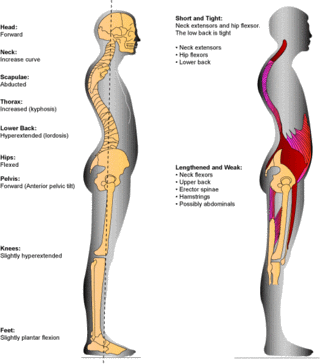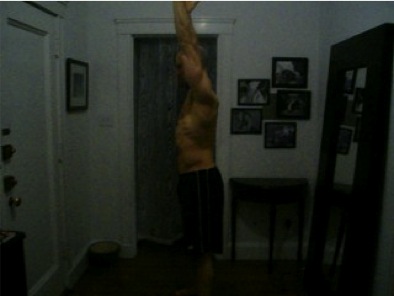Collapse the Ribs if You Live In Extension
I spend the majority of my day working with people who live in offices, cars, and couches, meaning their predominant posture is one of serious lumbar flexion, thoracic kyphosis, and a serious case of Mr. Burns posture. All they need to do is tent their fingers and say “Excellent” and you have a classic Simpsons character, complete with a mighty hump.
This is easy enough to work with, and there’s a ton of resources out there to get people back to neutral, strong, and able to destrominate the gym in every way imaginable (destroy + dominate = destrominate).
Conversely though, are the people who tend to exhibit the opposite posture, where they pretty much live in extension. They tend to have some trickier elements to work on, and their cueing may be completely different than those who live in flexion.
TO use Janda’s concepts, this is a classic lower cross syndrome. It’s less common to see, but more frequent than you would think. Instead of thinking about what muscles are short and tight and which ones are stretched and weak, let’s look at what the person complains of or exhibits:
1: chronic low back pain that doesn’t materialize from specific movements, isn’t a sharp stabbing sensation like a flexion intolerance, but more of a generalized ache.
2: chronically tight hip flexors, typically made worse when standing for long periods of time.
3. Reduced hip internal rotation, pelvic anterior tilt, and a lower rib flare anteriorly. We’ll cover that last one more in this post.
One of the big things that happens with this kind of posture is a heavy reliance on hinging at the thoraco-lumbar junction (where the thoracic spine meets the lumbar spine) to create any kind of stability through the spine. Essentially, by sitting on the end range of movement of the joint and grinding the facet joints together, you can get pretty stable, but the downside is this default program doesn’t make the deep core muscles do their job, essentially providing stability without the ability to react to different situations.
Another interesting fact is these guys tend to have a lot of the same tension and trigger point issues along their pec minor as flexion based guys, but also tend to have a hell of a lot more problem areas through their serratus anterior and rectus femoris through their thighs. From a breathing perspective, which I have always said is incredibly important, these guys and gals can nail diaphramatic breathing like no one’s business, as that’s what they use to keep their T-L from sliding around, so it’s super strong and powerful, but ask them to try to get their intercostals and scalenes to go for a ride, and they wind up almost on lock-down.
This plays a direct role in those trigger points I mentioned earlier, as the muscles are sitting locked down and not functioning properly. A dysfunctional muscle grows its’ own type of rust in the form of sticky adhesions, so getting the muscles to slide and glide properly releases the adhesions, but in many cases only once the adhesions have been brutalized through things like ART, Graston, and the like.
Since these guys and gals live in extension, they tend to have issues with the lower ab activation, transverse coordination, and getting the rectus to fire up to prevent moving into extension again. That being said, we could spend all day trying to work on these individual muscles, and the end result will be the person going right back to their default posture again and again, but this time with fatigued muscles that are supposed to be picking up the slack and working together.
What we need to focus on is correcting the posture, not training the muscles.
One aspect of coaching that I have found very beneficial in cueing people who live in extension is to get them thinking about their rib position. Let’s face it, no one can see if they are in extension, flexion or neutral, so trying to get them to visualize that is pretty much a lost cause. However, if they happen to have eyes like a crab, and have the ability to look behind themselves, they could definitely give it a try, but that may freak out a lot of people in the average gym.
One aspect that most people can see with very little effort is where their ribs are and whether they’re flaring out or hanging in a fairly neutral position. A lower rib flare is directly related to someone hanging out in extension, and when they look down they can see what’s going on pretty quickly.
Not to throw anyone under the bus here, but let’s use my buddy Tony Gentilcore as an example for educational purposes. He asked me to help him with some low back pain he was dealing with, and after checking his movements in some pretty basic patterns, it was clear he was a big extension lover. From all the deadlifts the guy does, it’s not surprising, as he’s been able to get really successful pulls by getting into a short spine position which involves a lot of extension. The extension caused his lower ribs to flare out, as evident by the pic below.
It’s not a major flare, but enough to be visible. Now the real interesting thing comes when he needs to find stability, say like when doing a bird dog exercise. Watch the difference between his left side and his right side when performing the movement in this video, and see what happens to his spine.
While the video isn’t ideal, you could probably see that when his right knee was on the floor, he could find stability through the hip and core without extending the spine, but when he tried to do the same thing with his left knee on the floor, he had to go through a big extension moment at the T-L and lumbar spine to get to a joint position favourable enough to provide the stability.
This isn’t a strength issue at all. Tony’s a freakin beast, and can pull more weight than most people on the planet, so thinking in terms of “strengthening weak” doesn’t apply. What he had to do was instead work on re-programming how he moved.
One way Tony and I were able to get him back in action was having him do a lot of exercises that if left to his own devices would push him into extension, but he had to resist it. These anti-extension exercises helped to correct the bias of always wanting to go to the end of the range of motion. One of the best examples of this is a dead bug movement.
I prefer to use a small towel under the lumbar spine to maintain a neutral lumbar curve, but also provide feedback as to whether the person is going into extension or not. If they maintain contact with the towel, they aren’t extending.
One thing I didn’t use with Tony, and am kicking myself for not including it, is a cue I’ve been using very successfully with a lot of my clients to help pull the rib flare in and create a new level of stability through the T-L junction without pushing the person into a big flexion bias counterposition.
The big cue was regarding the rib flare, and trying to reduce it. Essentially, with women I have them pretend they are trying to “collapse their ribs” under the bra strap so they feel like they’re pulling away from it and making the hoop under the strap smaller. With guys, depending on what they do on the weekend it may be the same cue, or I could have them think in terms of a heart rate monitor or simply putting their hands on their ribs and drawing in.
This movement causes the upper attachment of the rectus abdominis and obliques to work together to produce a movement that causes the rib flare to be drawn in. In conjunction with this, there is typically a concommitant alteration in the pelvic posture, whereby they tend to move back to normal with the up-regulation or the rectus and obliques. This “triple-whammy” is one of the reasons I love this kind of cue: multiple benefits with minimal effort.
The big trick is to get the individual to hold the ribs down, maintain a neutral posture, and then also breathe in a relaxed manner while simultaneously doing whatever kind of crazy concoction of an exercise I want them to go through, which is essentially like trying to pat your head, rub your tummy, sing “Goombaya” while balancing on a unicycle.
Give it a try right now. Sit up tall, and think of using the ab muscles to pull your ribs in tight without pulling you into a spinal flexion. Once you feel you have the tight tense band of muscle activity going on around the ribs, try to hold it and take deep breaths. It’s a tricky bugger, that’s for sure!!
If you’re one of the lucky ones who tend more towards extension than flexion, congratulations!! You’re the exact opposite of what 90% of all training programs are working towards!! So doing the same program can make you actually worse.
Does this work for you? Not at all? Drop a comment below and let me know what kind of cues you use or find helpful with yourself for getting into a decent posture to lift copiously heavy things in pain-free Beast Mode.




56 Responses to Collapse the Ribs if You Live In Extension